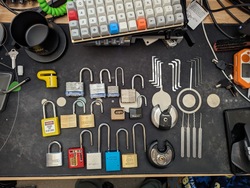Hey all, just wondering if anyone has any good self-hosted security cam recs? Have plenty of space and server options, and next big thing on my list is to get rid of my battery cloud cams. They have worked well enough I guess for a few years, but really pretty slow and limited, wondering if anyone has experience with any self-hosted solutions, preferably with similar features ie: motion detection, app/webapp, maybe battery op?
For non cloud cams, someone posted here a while back about thingno firmware, takes cheap cams off the cloud. Works great on a wyze cam and was a gamechanger for me. Sttrroonngglllyyy recommend
I had never heard of this so went looking. Super useful stuff here!
A link for anyone interested: https://thingino.com/
I see it supports many cameras, but you need to pull them apart and use a serial hookup to flash the firmware… but for the wyze cams and a few others you can flash them directly with an SD card.
I liked how cheap the wyze cams were but desperately wanted to get them offline. This was my silver bullet.
Holy sht. I know what im doing this weekend.
Oh thank god. This solves my problem of no good integrated cam hardware on the market that isn’t cloudified or a huge security hole.
@empireOfLove2 @Windex007 Just keep them off the network. There is no reason for a security camera to have LAN access.
How you gonna get the video feed off an IP cam and onto your NVR without connecting it to your network?
You’re not seriously suggesting using old analog cameras in 2025, are you?
Maybe they mean main network? Lots of people seem to have a separate vlan with strict rules on what they can cobtact for IoT devices nowadays due to how poorly secured they are.
Can confirm. Been using Wyze cameras for several years.
I’m not using this particular firmware but I bought them specifically because I could flash them.
Despite the firmware giving control of outbound traffic, I suggest blocking them at the network level.
Mine run on an sd card and if someone removes the sd card and reboots it or the card gets corrupted, it would fall back to factory settings.
I have quite a few of these and they are using very, very cheap sd cards and while none have failed, they most certainly will eventually.
New to me & bookmarked. I am sure I have some crap lying around that this would work with.
Thank you!
Came here to suggest this. Glad its getting the exposure it deserves
Thanks, never heard of it, do have an old Wyze cam or two lying around too.
Frigate + Reolink (or actually Frigate-approved cams)
Amcrest seems to be the cheapest and I have good experience with them and Frigate
Used them before, but you have to be kinda careful with Amcrest, every once in awhile they throw one out that is especially shitty to self host.
This is a good point, I actually made that mistake once! It required their app to setup.
My amcrest cameras have been good, but hikvision has been even better. They’re sneaky though so make sure they’re on an isolated vlan.
I have 3 imou dahua chinesium wifi cameras which are working nicely. They would be even better if I could get some cable to them. I think the most important aspect is the onvif protocol, then the encoding should be standard h264 no other bullshit, then cable if possible.
I love frigate so much!
That’s what I like about the hiks I have. They are configurable from the web browser. Some of my amcrest I had to bang an API over curl to keep the time zone set
Slightly off topic and something I read from somewhere else, but make sure whatever you use can write the date & time onto the camera images, otherwise it isn’t usable for any police / insurance claims.
I’d guess all systems do this now, but just wanted it to be on your checklist of features.
If the camera doesn’t do it, then the storage server must.
(And make sure the clock is sync’d to something 😉)
Noted, good point, thanks!
whatever you use can write the date & time onto the camera images, otherwise it isn’t usable for any police / insurance claims.
Weird. I mean, could you just access the properties of said picture to reveal the date taken?
Meta data could be edited/unintentionally overwritten
Sure, but the same is true for embedded timestamps. Just put a black bar over it with the time and date in white. Claim that the system does it that way, done.
If the timestamps on the current live cctv image looks completely different, then you’re out of luck using it as evidence.
After all, it’s your video evidence, why would you want to fake it if you’re trying to prove that someone stole that Amazon parcel off your front door step…
This isn’t X-Files… 🛸
Reolink cameras are self-hosted. You don’t have to have an account in their app, and nothing is synced to the cloud. It’s all stored locally. They’re expensive cameras by comparison, but a. they’re really high quality, and b. they’re not subsidized by subscription fees.
Be careful with reolink, their P2P solution is pretty suspicious. No body really knows how it works and who it shares the data with.
You can disable those features, but it will stop reolink app from working.
They have never explained how the peer-2-peer network works, and it security and privacy is quite unknown.
Reolink is Chinese, which doesn’t really help these concerns.
Better to selfhost frigate and just rtsp cameras there.
I would assume it’s based on TURN or STUN, since you don’t need to log in. What makes it suspicious?
Edit: I did some reading on their blog, and they only mention something like STUN and specifically say it’s only for connection, not for relaying, so I don’t think they use TURN. In that case, the camera is streaming video directly to your phone, so it sounds like it’s not ever passing through a ReoLink server. The benefit to ReoLink is they only have to run a STUN server, which is incredibly cheap (bandwidth wise), and the benefit to you is that the video never goes through anyone else’s server. The drawback is if you have a really restrictive firewall, or some funky address translation, you might not be able to establish a connection.
The problem is that it can only be speculated how they work, because they have not published it. That is quite suspicious in my book.
I personally would avoid reolink and use rtsp + frigate + ha, to have full control with known open source selfhosting solution.
I understand that people like the easy setup, but if you already do selfhosting, it isn’t that big jump.
Sure, but I’ve tried Frigate, and it’s not even close to Reolink in terms of ease of use. It was a giant pain in the ass to get it working to detect people in the camera. And even then, getting a push notification is something I couldn’t even figure out. And using it on a phone is really bad UX.
I recently added two reolink cameras to my setup. Out of the box, they would not let me assign them IPs, they did not even try to get an IP from my network. They needed to be connected to via the mobile app the first time, then reconfigured for IP. Wasn’t a great user experience even if the cameras are now fine.
Onboarding a networked device should not require a mobile app, fill stop.
But you still kept the cameras and didn’t return them… Where’s the full stop? lol
Well I certainly won’t be buying anymore, and I’ll be letting anyone who asks know about my shitty experience, but yeah, you’re right. Partial stop.
How would you connect them to your network? They have no inputs.
Well shit I wish someone would have told me that before I directly connected them to my switch via Ethernet.
They’re PoE, rlc-520a. They absolutely have inputs.
Oh ok. I was thinking wifi. Yeah, that’s strange that they won’t work with direct ethernet.
I had 2 of these for years ran back to Synology surveillance station and they were great. I’ve expanded to 6 cameras now and bought the Reolink NVR. It works great, with good picture quality. Pretty inexpensive setup overall. No downtime. Very happy with Reolink.
Reolink camera
Nice, had heard the name, but looking at their site, didn’t realize they had so many options, and no cloud requirement! Awesome, looking like the likely option, thanks!
This is maybe controversial, but I love the Ubiquiti security stuff. Cameras (interior and exterior) doorbells, etc, it’s all great. Pricey, but you get what you pay for.
And the data can stay local or be accessible via their services.
I chose to go local only, grabbed their UNVR and populated it with 4x 2TB drives and it has enough space to handle 7 cameras HD history for about a month.
I’ve experimented with ubiquiti cameras and for the most part I find them very overpriced for their quality point. They’re good cameras, but they’re not ONVIF compatible so if you want to get into their (super overpriced and limited) ecosystem you won’t be able to intermix other cameras easily.
A good example is their doorbell camera. It’s just not good. And they don’t have more than one model, so if you want a good one you’re buying something else, that won’t work in their software, so now you’re using two systems to watch your cameras.
I’m glad they work for you, but I don’t recommend getting into their camera ecosystem.
UniFi Protect now has limited ONVIF support allowing various 3rd party cameras to work with Protect.
UniFi cameras can have RTSP enabled also, but it requires UniFi Protect to enable the setting.
Their support for ONVIF is, as you said, limited. Being able to add a camera into your protect feed is a good start, but until they make it work better for PTZ, audio, sub stream capture, and everything else it’s not worth note IMO.
RTSP allows you to check a live feed in another software suite (even just VLC) but again, without the cameras themselves being ONVIF standard you’re missing all the aforementioned features and now you’re really REALLY overpaying for what is essentially a dumb camera.
requires UniFi Protect to enable the setting.
Always some sort of cloud based dicking around with Ubiquiti stuff. I’m so over them.
Unifi Protect is what runs on the CloudKey/NVR physical device - you don’t need to have it go through to the Internet.
Remember, for better or worse Ubiquiti is positioning themselves as SMB Enterprise security - some companies won’t want their footage to be accessible outside their network.
You can self host Protect. It’s what I did for ages when I was using a few of their cameras. Don’t have to use cloud unless you want to.
There’s a lot of downsides to ubiquiti (I’ve been dunking on them all over this thread) but there’s a LOT of great stuff too, and being able to self-host their management suite if you choose to do so is GREAT. That doesn’t make me want to invest in their walled garden for cameras, but for people who want to get into a functional ecosystem they’re a great choice. Overall the price:performance curve is not worth it to me, though, but neither are apple products, even though I know they work well also.
+1 for Ubiquiti. I’ve got a Dream Machine and 5 camera hooked up, it’s great.
Frigate is popular.
I used to use ZoneMinder, it worked well, but you must be very familiar with onvif, primary/secondary channels, and key frames for it to work well.
I only switched to frigate because of the person/animal detection. It’s ok, but it does need some polish in a few areas like event retention, and it could stand some more approachable documentation.
Used Zoneminder for a 20 camera store CCTV setup and can confirm, it’s complicated but powerful. I wouldn’t use it for less than 4 cams.
The alternative I’d use personally is https://motion-project.github.io/ though. Doesn’t make much difference.
I have a Reolink PoE camera. It works fine. As far as I can tell, it only uses the internet to check for updates and set the time, but I have it blocked off anyway. Home Assistant was actually causing it to check for updates, too, so that got disabled.
I don’t record, so I can’t help you there.
I will say that is a pain to get Home Assistant to display real-time video instead of a slide show.you managed to get it in realtime though? may i ask how?
I haven’t, that’s the problem. It seems like it’s possible, but I’ve given up trying for the moment.
Eh? Shouldn’t it be real time already?
this is my configuration:
- camera_view: live type: picture-glance entities: [] camera_image: camera.cam_profile000_mainstream tap_action: action: noneI am using ONVIF integration for the camera.
Mine even play audio
that’s weird i have some reolink cameras and they display fine through home assistant
It displays fine by default, but the image only updates every several seconds. I’m talking about a live video feed, which needs some kind of special frame which has to be bolted onto HA somehow.
Any cam with an rtsp stream is fine. Host frigate on your server point it to the cams you can get audio and video and object detection pretty easily. I also recommend taking an extra step and creating a firewall rule to block the cams’ inbound/outbound internet traffic.
For hardware, anything that can provide a local rtsp stream is a good place to start. I run cheap and cheerful mix of tapo, unbranded and homebrew esp32 cams. Offload the motion/object detection and alerts to something that can pull in the feeds, and isolate the cams to local network only.
WiFi usually ok, but at least hardwire the power to save future grief.
Using frigate to manage mine, which is running under Homeassistant - another project worth looking up.
A few images, featuring Freddie the visitor:



Tell me more about your homebrew esp32 cams, please!
Ok so the combination is:
- This camera board
- This external antenna
- This project
- A shell I designed myself in SketchUp (skp download). Note that’s not the final version, as I lost some design files.
And the finished item:

All assembled, they will give a decent enough feed to frigate for the basics. Just don’t expect miracles in the resolution or framerate departments. 3fps does fine for my use case of tracking critters.
Neat, thanks!
I’m not thrilled about the camera quality (compared to a purpose-built surveillance cam with 4k and good low-light performance) and I wish it had PoE, but damn, can’t beat that price!
(Side note: does anybody else find it weird that PoE is so uncommon and/or adds so much to the cost of these IoT dev boards? I get that normal people don’t want the hassle of running cable, but it feels like the hole in the market is bigger than it should be.)
It would definitely be a size thing for adding Ethernet (PoE or otherwise) to small boards like these. The ones I am using are already bigger than they ought to be - the bottom half is just a glorified serial interface and power input for USB. The esp plugs into this through pin/header. If I were less lazy, they could be about half the thickness in a final product. No PoE I suppose also keeps them cheap, which is always good for me. The casings were my first ‘proper’ design and entry into resin printing.
The Tapo kit I have found to be a good balance of price, features and quality. I have a Tapo C310 mounted outdoors at another building, which has done great in all weathers. Initial setup does require the app/service last time I checked, but it can be made to serve RTSP locally after that. Very good for the ~£30 price point.
Gladly. I’ll collate a few bits later - time for work.
Thanks, looks cool, frigate certainly seems the way to go.
Make sure any cameras you get are ONVIF compatible. That’ll give you the widest usability.
And while it’s great to be self-hosted, I’ve never found anything as good as BlueIris for camera software, even if it does cost $50/yr. I run it in a Dockurr/windows container, there’s a few projects out there that make Dockur easier to set up.
I personally use Frigate, which is default free, but has a plus tier for $50 a year (has custom AI training/models instead of default’s standard model).
Personally has all the features I’d want, curious what BlueIris brings, I’ve heard a bit about it.
I’d have to look at Frigate again, but I’ve used BI for a few years now for myself and neighbors that I’ve installed livestock monitoring cameras for. The phone app is quite good, it does very reliable recognition via Deepstack, it’s compatible with so many cameras it isn’t funny, and the automations are very extensive. Setting up schedules is pretty intuitive.
The geofencing is terrible, but that’s about my biggest complaint with it, besides having to install it on a Windows VM. I did have it working in Wine years ago, but it wasn’t very stable.
BlueIris
Right on, never heard of it, will check it out for sure…thanks!
Dahua and Hikvision have great cameras but of course you shouldn’t trust them. Block them at the firewall. I bought mine a few years ago and preferred Hikvision for its better built in webserver for initial configuration.
On the hosting side you run Frigate, Zoneminder or BlueIris (Windows) to control the cameras and record their streams.
@Blue_Morpho @jabeez Huh I preferred Dahau. Thought the interface was nicer and the cameras low light looked way better.
Dahua must have improved their software. I was trying every brand of camera about 8 years ago when I setup my system. The first Dahua I bought required their ActiveX component for Internet Explorer to see the camera output from their web interface!
I agree that Dahua looked better but at the time their web interface was so bad I kept the Hikvisions.
When I needed this I reached for whatever generic rtmp cameras were well rated. Blocked them from external access (including outgoing!) at the firewall level and used Zoneminder and some custom scripts to monitor.
I found out reolink cameras have an official integration partnership with home assistant. I just installed my front door camera.
I’ve been looking at Reolink for a doorbell. They have PoE on them which is a win for my needs.
Can we pin one of these posts? The same thing gets asked even few days and the answers don’t change nearly that frequently
Sigh, unfortunately not.
You should see the Linux community asking about which distro to use - now that’s where a pinned post is needed…
I’m fine with repeating “I use Arch btw”
Me too (btw).
Huh? There’s a post about exactly that pinned at the tops of [email protected] for quite a while. Maybe I’m misunderstanding what you’re saying.
Well, slap me sideways with a boxed edition of Windows XP SP3.
I never knew that!
Thanks for sharing.
Haha, no problem!
Really? Sorry, didn’t see any others going back weeks, you have a link to another I could check out?
I have Amcrest PoE cameras hooked to an Amcrest NVR for 24/7 recording and also Frigate running separately tied to Home Assistant to record clips and send notifications when people are out front/back of my house. It all works really well thus far after about a year of use.
Nice, checked them out, look like really nice cams, leaning towards battery doorbells to not have to deal with any wiring. Would love to have PoE, but sounds like a lot of work!
It was definitely not fun stringing Cat6 through the attic, but knowing myself, I probably wouldn’t have stayed on top of battery changes and I also wanted 24/7 recording since a battery powered camera can miss movement and start recording late or not at all. I also need a doorbell camera still but I’ve had trouble finding one that checks all the boxes.












